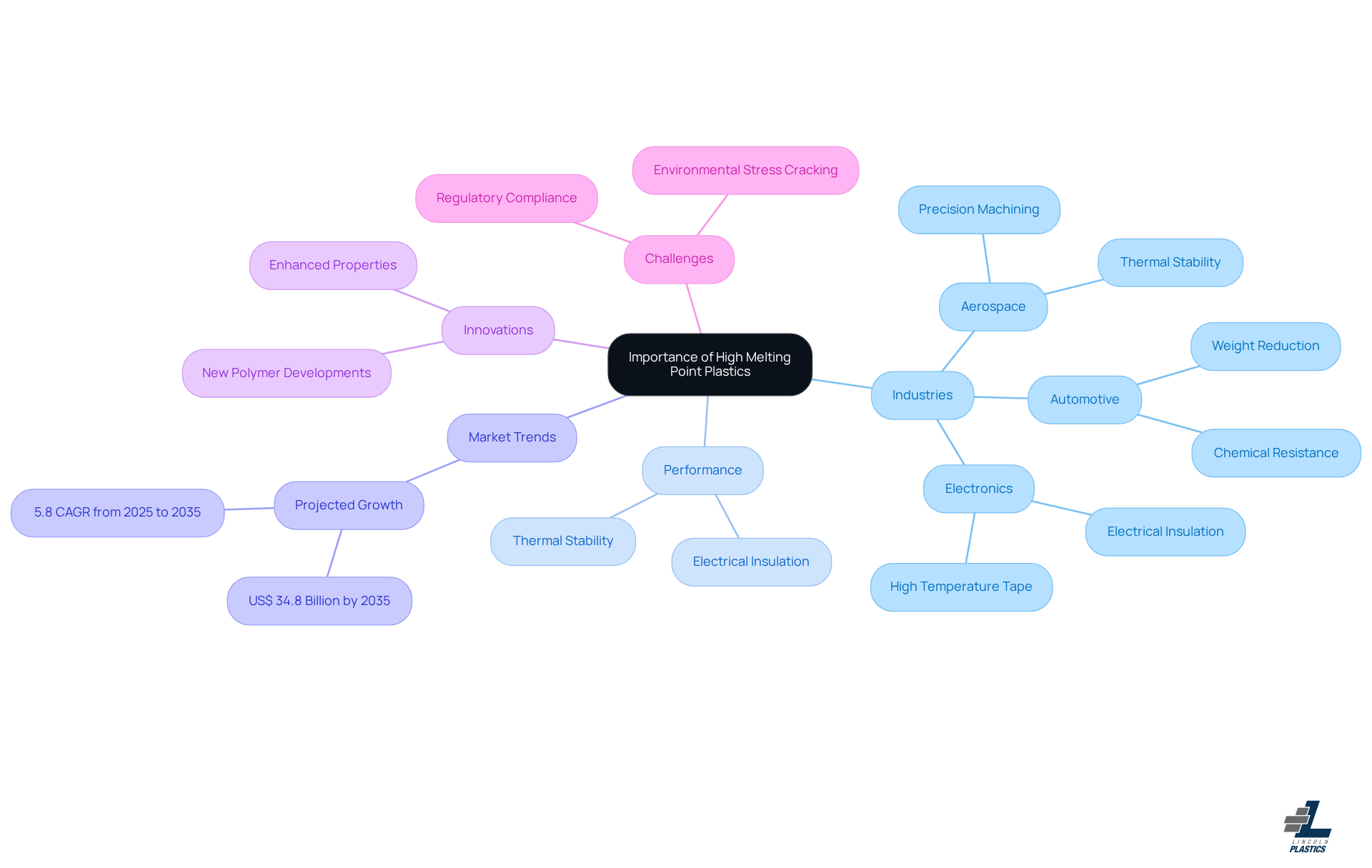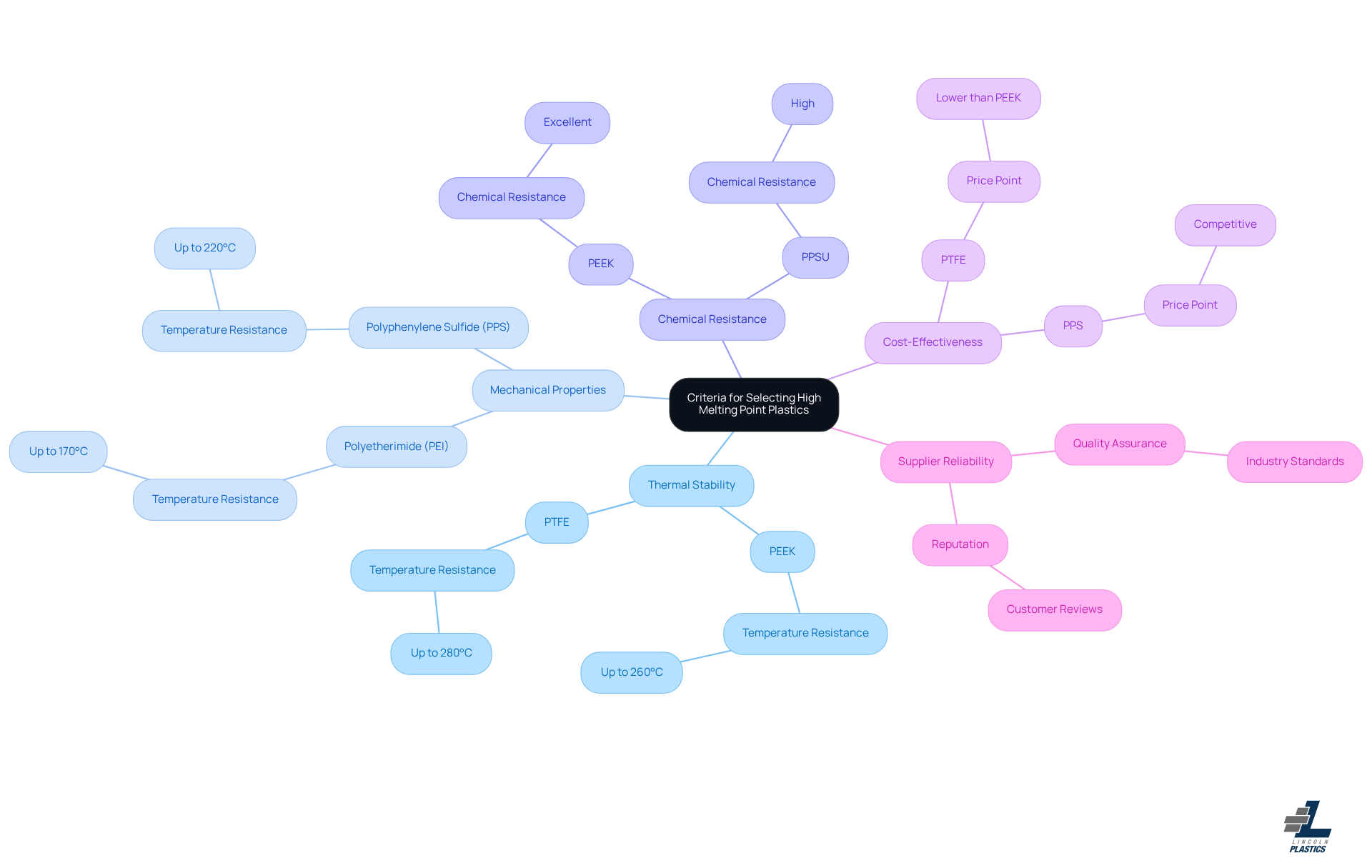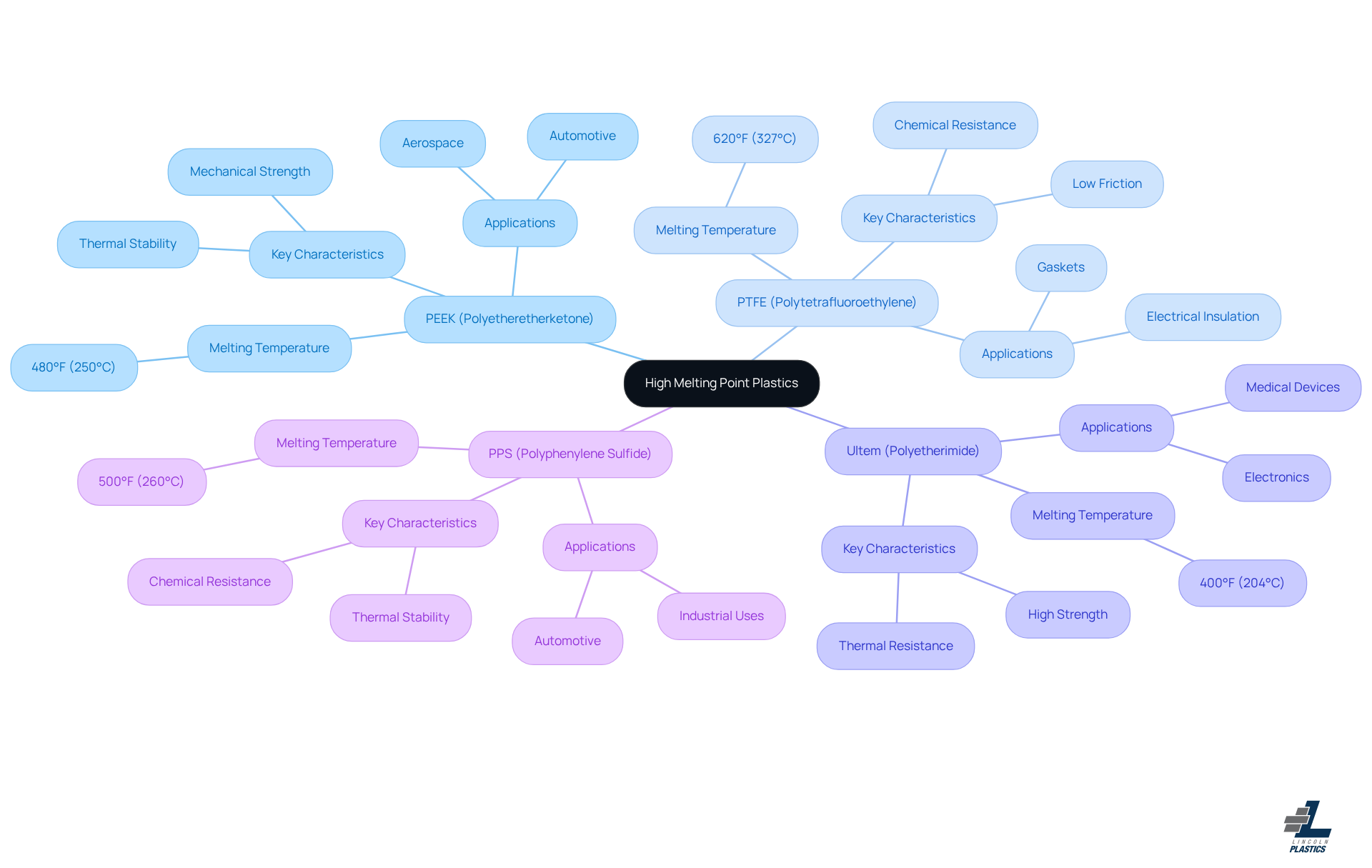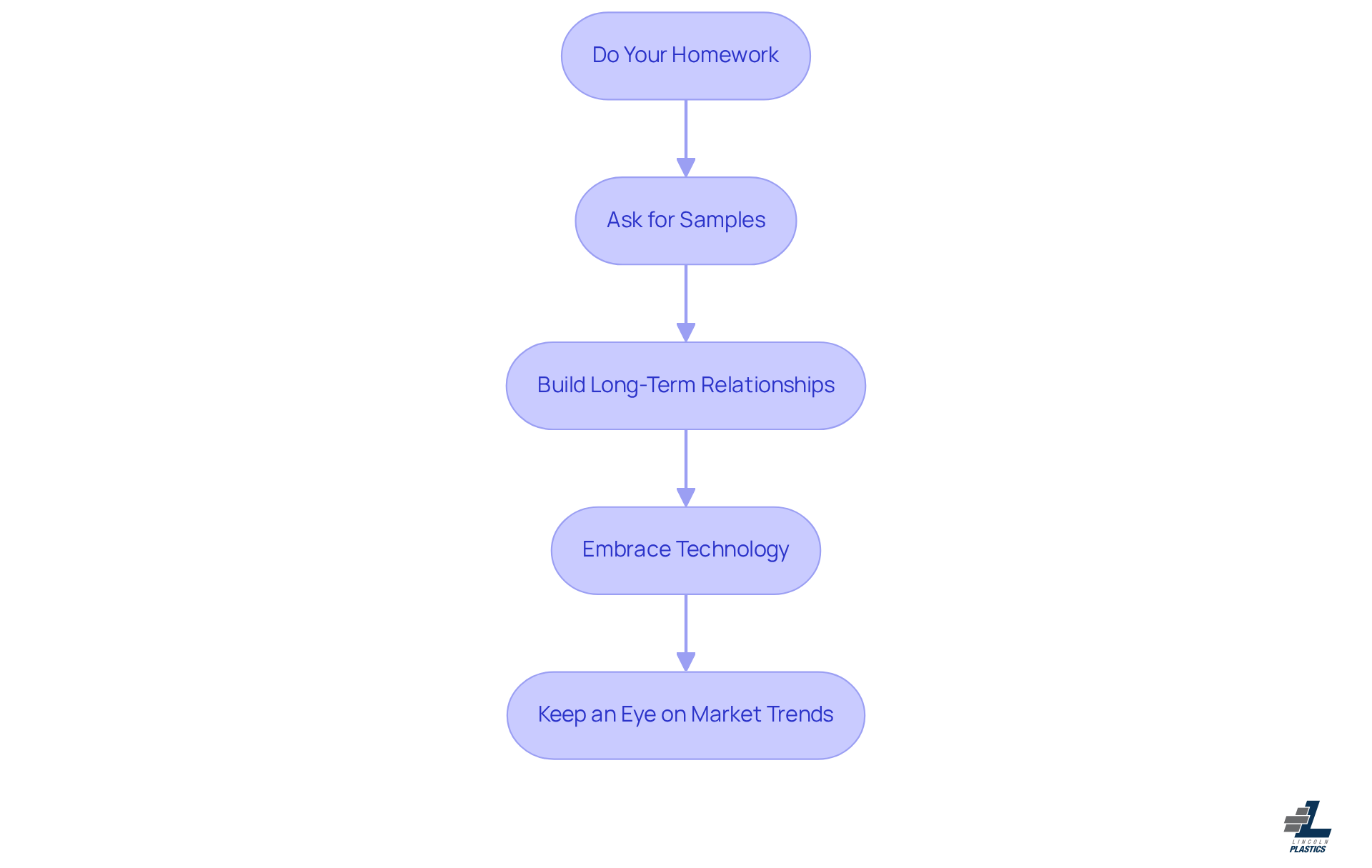
Best Practices for Sourcing Plastic with High Melting Point
Introduction
In industries like aerospace, automotive, and electronics, you might have noticed a growing demand for high melting point plastics. These materials are crucial for keeping performance up in extreme conditions. So, what’s the deal? This article dives into how to source these essential materials, showcasing the fantastic benefits they bring, like durability, thermal stability, and chemical resistance.
But here’s the kicker: with the market projected to reach billions, how do manufacturers choose the right suppliers and materials? It can feel overwhelming, right? Let’s explore some insights and solutions together, so you can ensure reliability and efficiency in your applications.
Understand the Importance of High Melting Point Plastics
In industries like aerospace, automotive, and electronics, materials such as plastic with high melting point are super important, as parts face some serious heat. Think about it: materials like PEEK and PTFE are built to handle intense thermal stress without losing their shape. This means they keep things reliable and safe in critical applications.
Now, let’s talk about the aerospace industry. Using plastic with high melting point can significantly enhance component performance when temperatures rise, resulting in improved system efficiency and safety. At Lincoln Plastics, we’re all about working closely with OEMs to make sure our products meet tough quality standards. We keep tolerances tight - within ±0.002mm - during precision machining of avionics materials to ensure everything runs smoothly.
Our quality system is robust, with dedicated documentation for each polymer profile, ensuring compliance and traceability. And guess what? The market demand for these materials is strong! Forecasts suggest that the elevated temperature polymers (ETP) market will hit around US$ 34.8 billion by 2035, growing at a rate of 5.8% from 2025 to 2035. That’s fueled by their crucial role in advanced applications.
But it doesn’t stop there! Developments in polymers, particularly plastic with high melting point, are popping up all the time, with innovations that improve their properties and expand their uses in electronics. They offer fantastic thermal stability and electrical insulation. However, manufacturers need to keep in mind challenges like environmental stress cracking (ESC) when machining amorphous thermoplastics like Ultem®.
This mix of durability and performance, along with our commitment to regulatory adherence and quality assurance, makes plastic with high melting point a preferred choice for producers looking to meet the strict demands of modern engineering.

Establish Criteria for Selecting High Melting Point Plastics
When it comes to picking high melting point plastics, manufacturers really need to keep a few key things in mind:
-
Thermal Stability: First off, you want to make sure the material can handle the heat without breaking down. Think about high-temp materials like PEEK, which can take the heat up to 260°C, or PTFE. These guys are built to withstand some serious conditions, making them ideal for tough applications.
-
Mechanical Properties: Next, let’s talk about how strong the material is. You’ll want to check out its tensile strength, impact resistance, and flexibility when things heat up. For example, Polyetherimide (PEI) keeps its cool up to 170°C, while Polyphenylene Sulfide (PPS) shines with great mechanical strength at temperatures hitting 220°C.
-
Chemical Resistance: Now, how well can the material stand up to chemicals? This is super important! High-performance materials like PEEK and PPSU are known for their amazing chemical resistance, making them perfect for environments where they might come into contact with harsh substances.
-
Cost-Effectiveness: Let’s not forget about the budget! It’s all about finding that sweet spot between performance and cost. Sure, high-temp polymers can be pricier, but materials like PTFE and PPS often come in at a lower price point than PEEK or PI. Their durability and performance can really justify the investment in key applications.
-
Supplier Reliability: Finally, you want to choose suppliers who have a solid reputation for delivering quality materials and support. Working with manufacturers who prioritize quality assurance and meet industry standards can really streamline your procurement process.
By keeping these criteria in mind, you can narrow down your options and find the best plastic with high melting point for your needs. This way, you’ll ensure reliability and effectiveness in your products!

Evaluate Top High Melting Point Plastics for Industrial Use
When it comes to industrial applications, several plastics with high melting point options really stand out. Let’s dive into a few of them:
-
PEEK (Polyetheretherketone): This one’s a superstar! Known for its incredible thermal stability and mechanical strength, PEEK can handle temperatures up to 480°F (250°C). It’s a go-to choice for aerospace and automotive industries.
-
PTFE (Polytetrafluoroethylene): Ever heard of Teflon? That’s PTFE for you! With a melting temperature of 620°F (327°C), it’s super resistant to heat and chemicals. Perfect for electrical insulation and gaskets.
-
Ultem (Polyetherimide): This material packs a punch with high strength and thermal resistance, melting around 400°F (204°C). It’s ideal for medical devices and electronics.
-
PPS (Polyphenylene Sulfide): If you need something that can take a beating, PPS is your friend. With a melting temperature of about 500°F (260°C), it’s known for its outstanding chemical resistance and thermal stability, making it great for automotive and industrial uses.
So, why does this matter? Understanding these materials and their unique characteristics can really help producers select the right plastic with high melting point for their specific needs. What do you think? Ready to explore these options further?

Implement Best Practices for Sourcing High Melting Point Plastics
When it comes to sourcing plastic with high melting point, manufacturers can really benefit from a few best practices. Let’s dive into them!
-
Do Your Homework: First off, take some time to research potential suppliers. Check out their reputation, product quality, and customer service. This step is super important! Did you know the market for elevated temperature materials is projected to hit USD 85.93 billion by 2034? That just shows how crucial it is to partner with reliable suppliers.
-
Ask for Samples: Before you place any big orders, make sure to request samples. This way, you can see how the material performs in your specific applications. Many manufacturers have found that testing samples helps them avoid costly mistakes down the line. It’s all about ensuring compatibility with your production needs!
-
Build Long-Term Relationships: Establishing solid partnerships with trustworthy suppliers can lead to consistent quality and support. In the market for materials like plastic with high melting point, having dependable suppliers is key. You want to maintain those high standards, especially for performance-critical applications.
-
Embrace Technology: Don’t forget to leverage digital tools and platforms for sourcing! They can really streamline your procurement process and give you access to a wider range of materials. This not only boosts efficiency but also helps you stay competitive in a fast-paced market.
-
Keep an Eye on Market Trends: Staying updated on advancements in plastic with high melting point and new suppliers is essential. The market is booming, especially with rising demand in sectors like aerospace and automotive. So, keeping up with the latest developments is a must!
By following these practices, you can improve your sourcing efficiency and ensure you’re getting the best materials for your applications. This ultimately leads to better product performance and operational success. So, why not start implementing these tips today?

Conclusion
Sourcing plastic with a high melting point is super important for industries that need materials that can handle extreme conditions. Think about it: high-performance plastics like PEEK, PTFE, and Ultem not only boost the reliability and safety of critical components but also help systems in sectors like aerospace and automotive run more efficiently. By getting to know the unique properties and applications of these materials, manufacturers can make smart choices that fit their operational needs.
Now, when it comes to picking high melting point plastics, there are a few key things to keep in mind. You’ll want to consider:
- Thermal stability
- Mechanical properties
- Chemical resistance
- Cost-effectiveness
- Supplier reliability
Each of these factors is crucial for making sure the materials meet the tough demands of modern engineering. Plus, following some best practices for sourcing-like doing thorough research, asking for samples, and building long-term relationships with suppliers-can really streamline the procurement process and boost product performance.
The growing market for elevated temperature polymers really highlights how important it is to adopt effective sourcing strategies. As demand keeps climbing, staying updated on market trends and using technology will be key for manufacturers who want to stay ahead of the game. Embracing these practices not only ensures you have access to top-notch materials but also sparks innovation and excellence in product development. So, why not start exploring these options today?
Frequently Asked Questions
Why are high melting point plastics important in certain industries?
High melting point plastics are crucial in industries like aerospace, automotive, and electronics because they can withstand intense thermal stress without losing their shape, ensuring reliability and safety in critical applications.
How do high melting point plastics enhance performance in the aerospace industry?
In the aerospace industry, high melting point plastics improve component performance at elevated temperatures, leading to enhanced system efficiency and safety.
What manufacturing standards does Lincoln Plastics adhere to for high melting point plastics?
Lincoln Plastics maintains tight tolerances of ±0.002mm during precision machining of avionics materials and has a robust quality system with dedicated documentation for each polymer profile to ensure compliance and traceability.
What is the projected market growth for elevated temperature polymers (ETP) by 2035?
The elevated temperature polymers (ETP) market is forecasted to reach approximately US$ 34.8 billion by 2035, growing at a rate of 5.8% from 2025 to 2035.
What are some properties of high melting point plastics that benefit electronics?
High melting point plastics offer excellent thermal stability and electrical insulation, making them beneficial for various electronic applications.
What challenges do manufacturers face when machining high melting point plastics?
Manufacturers need to address challenges such as environmental stress cracking (ESC) when machining amorphous thermoplastics like Ultem®.
Why do producers prefer high melting point plastics for modern engineering demands?
Producers prefer high melting point plastics due to their mix of durability and performance, along with the commitment to regulatory adherence and quality assurance, which meet the strict demands of modern engineering.
List of Sources
- Understand the Importance of High Melting Point Plastics
- High Temperature Plastics (HTP) Market is Projected to Reach US$ 34.8 Bn by 2035, Growing at a 5.8% | Fact.MR Report (https://einpresswire.com/article/785332731/high-temperature-plastics-htp-market-is-projected-to-reach-us-34-8-bn-by-2035-growing-at-a-5-8-fact-mr-report)
- High Temperature Plastics Market: Innovations, Demand Drivers & Global Forecast 2025-2032 (https://openpr.com/news/4124210/high-temperature-plastics-market-innovations-demand-drivers)
- High Temperature Plastics Market Size & Statistics 2035 (https://factmr.com/report/high-temperature-plastics-htp-market)
- High-Performance Thermoplastics in Avionics Materials | AIP Precision Machining (https://aipprecision.com/how-high-performance-thermoplastics-are-redefining-avionics-materials-in-2025)
- Establish Criteria for Selecting High Melting Point Plastics
- Heat-Resistant Plastics: Essential Guide - Jaycon (https://jaycon.com/essential-guide-to-heat-resistant-plastics)
- How to Choose Special Engineering Plastics for High-Temperature Environments (https://tuntunplastic.com/news/how-to-choose-special-engineering-plastics-for-high-temperature-environments.html)
- Master High Temp Plastic: Key Properties, Types, and Selection Tips (https://lincoln-plastics.com/news-post/master-high-temp-plastic-key-properties-types-and-selection-tips?dcc2137a_page=8)
- High Temperature Plastic Material : Comprehensive 4 Guideines (https://swcpu.com/blog/high-temperature-plastic-material)
- How to Select the Right Plastic Material for High-Temperature Applications | Piedmont Plastics (https://piedmontplastics.com/blog/high-temp-plastics?srsltid=AfmBOoqBbdr7I6ogmPTM57yhNX6gAM7sTOIJ6Nfym1t0mZpBOcerldW-)
- Evaluate Top High Melting Point Plastics for Industrial Use
- Master High Temp Plastic: Key Properties, Types, and Selection Tips (https://lincoln-plastics.com/news-post/master-high-temp-plastic-key-properties-types-and-selection-tips?dcc2137a_page=14)
- Top Performers: A Guide to the Best High Temperature Plastic Materials (https://atlasfibre.com/top-performers-a-guide-to-the-best-high-temperature-plastic-materials)
- High-temperature Sealing Material Competition: PEEK VS. PTFE (https://honyplastic.com/news/high-temperature-sealing-material-competition-peek-vs-ptfe-241112.html)
- Star Tribune (https://markets.financialcontent.com/startribune/article/abnewswire-2025-9-5-peekmaterials-launches-peek-film-a-breakthrough-polymer-for-extreme-environments)
- Implement Best Practices for Sourcing High Melting Point Plastics
- High Temperature Thermoplastics Market Global Forecast to 2022 | MarketsandMarkets (https://marketsandmarkets.com/Market-Reports/high-temperature-thermoplastic-market-174302360.html)
- Master High Temperature Clear Plastic: Selection and Sourcing Guide (https://lincoln-plastics.com/news-post/master-high-temperature-clear-plastic-selection-and-sourcing-guide)
- High Temperature Plastic Market Size, Share, Trends, Forecast, 2032 (https://fortunebusinessinsights.com/high-temperature-plastic-market-103788)
- High Temperature Plastics Market Size & Insights Report [2034] (https://businessresearchinsights.com/market-reports/high-temperature-plastics-market-125902)
- POLITICO Pro: US backs calls for plastic production reductions (https://subscriber.politicopro.com/article/2024/08/us-backs-calls-for-plastic-production-reductions-00174052)


